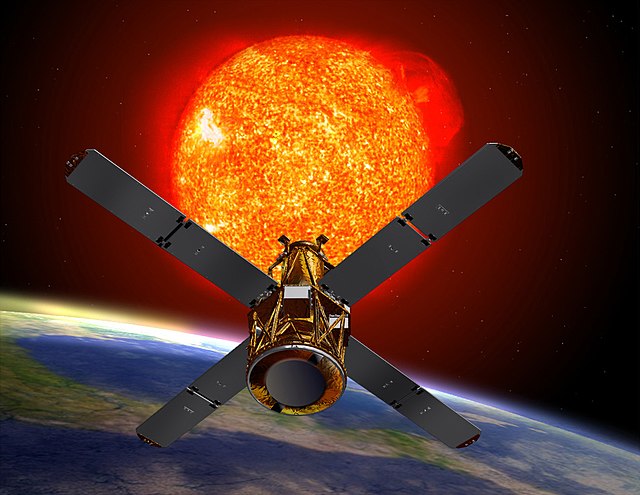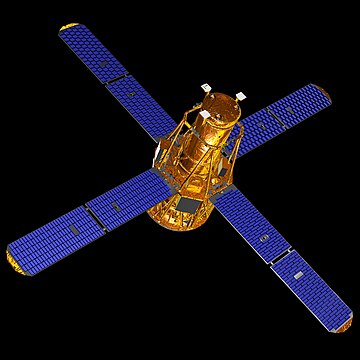拉馬第高能太陽光譜成像探測器(縮寫為RHESSI)是美國宇航局於2002年2月5日發射的一顆太陽探測衛星,主要目的是研究太陽耀斑中的粒子加速和能量釋放過程。這顆衛星原名為高能太陽光譜成像探測器(HESSI),為紀念太陽高能物理領域的先驅人物魯文·拉馬第(Reuven Ramaty)而更名為RHESSI。其觀測範圍覆蓋了從3 keV的軟X射線波段到20 MeV的伽瑪射線波段,並具有極高的譜分辨本領。美國宇航局戈達德太空飛行中心、美國伯克利加州大學、瑞士蘇黎世聯邦理工學院等機構參與了衛星的設計和建造。
 Illustration of RHESSI | |
| 名稱 | Explorer-81, SMEX-6 |
|---|---|
| 任務類型 | Solar observatory |
| 運營方 | NASA / Goddard Space Sciences Laboratory |
| 國際衛星標識符 | 2002-004A |
| 衛星目錄序號 | 27370 |
| 網站 | http://hesperia.gsfc.nasa.gov/rhessi3/ |
| 任務時長 | Planned: 2 years[1] Elapsed: 22年,8個月,21天 |
| 航天器屬性 | |
| 製造方 | Spectrum Astro[1] |
| 發射質量 | 293公斤(646磅)[2] |
| 尺寸 | 2.16乘5.76米(7.1乘18.9英尺)[2] |
| 功率 | 414 W[2] |
| 任務開始 | |
| 發射日期 | 2002年2月5日 20:58 UTC[3] |
| 運載火箭 | Pegasus XL |
| 發射場 | Stargazer, Cape Canaveral |
| 承包方 | Orbital Sciences |
| 軌道參數 | |
| 參照系 | Geocentric |
| 軌域 | Low Earth |
| 半長軸 | 6,875.9 km(4,272.5 mi) |
| 離心率 | 0.0011 |
| 近gee點 | 490.3 km(304.7 mi) |
| 遠gee點 | 505.3 km(314.0 mi) |
| 傾角 | 38.0367° |
| 週期 | 94.5667 min |
| 升交點黃經 | 59.1113° |
| 近gee點幅角 | 152.3223° |
| 平近點角 | 207.8129° |
| 平均運動 | 15.2265 rev/day |
| 曆元 | 2 September 2015, 12:16:06 UTC[4] |
| 公轉周數 | 74636 |
| 主望遠鏡 | |
| 類型 | Coded aperture mask |
| 焦距 | 1.55米(5.1英尺) |
| 觀測範圍 | 150 cm2(0.16 sq ft) |
| 波長 | X-ray / γ-ray |
| 解像度 | 2 arcsec up to 100 keV 7 arcsec up to 400 keV 36 arcsec above 1 MeV[2] |
Small Explorer program | |

參見
參考資料
外部連結
Wikiwand in your browser!
Seamless Wikipedia browsing. On steroids.
Every time you click a link to Wikipedia, Wiktionary or Wikiquote in your browser's search results, it will show the modern Wikiwand interface.
Wikiwand extension is a five stars, simple, with minimum permission required to keep your browsing private, safe and transparent.

